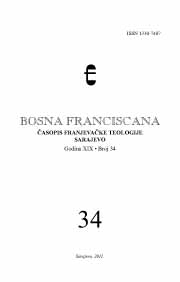Vjerske, kulturne i zdravstvene prilike u Srebrenici u prvoj polovini 15. stoljeća
Religious, Cultural, and Health Situation in Srebrenica in the First Half of the 15th Century
Author(s): Muhamed HusejnovićSubject(s): History
Published by: Franjevačka teologija Sarajevo
Summary/Abstract: In the f rst half of the fifthteenth century, Srebrenica was amongst one of the most developed areas of middle age Bosnia. As the economy grew, so did the corresponding population. The result of this, was that towns became overcrowded, and subsequently there were a number of people coming to the Srebrenica from many different areas. The ethnic structure was closely linked to the Religions and therefore the people of Srebrenica were of the Bosnian, Catholic and Orthodox Churches as well as the Islamic Religion. The importance of this area was shown by many facts, figures and certificates. The Area was the Headquarters of the Srebrenica-Visoko and this was the Diasis for both the Catholic and Orthodox Churches. At this time, as Srebrenica was developing, there were good conditions for people to write new scriptures. The town had its own writers, and this eventually became their permanent employment. The town Dukes, knew how to write and were personally issuing some documents themselves. People from Dubrovnik, were bringing their own books to Srebrenica. One part of Srebrenica’s cultural life, was dedicated to amusement and there were many artists who were entertaining the people of the town. Even though Srebrenica was one of the most developed areas, it was also one of the most polluted. In the first half of the fifthteenth century, there were different pandemics and illnesses, like Colera. Thanks to the Catholic Priests and the towns people, the Colera infected people were isolated in special areas to shelter them from the people who were not ill. Many people from Dubruvnik, who had lived in Bosnia for several years, left money in their wills upon their death, for the continuing support of the Colera shelters.
Journal: Bosna Franciscana
- Issue Year: 2011
- Issue No: 34
- Page Range: 219-234
- Page Count: 16
- Language: Bosnian
- Content File-PDF

